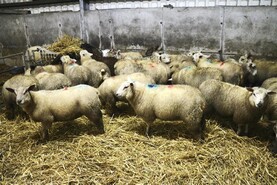Finishing lambs indoors
One of this week’s sheep features is an article written by Michael Gottstein and Michael Diskin, Teagasc, which looks at the potential of increasing the value of store lambs by carrying them through to finish. The article also outlines housing advice which is detailed as follows. Lambs can be housed in purpose-built sheep houses, or alternatively in any shed which will provide the basics in terms of water supply and ventilation. For sheds build after 2006 (to meet nitrates regulations), note they must have a concrete floor. Key requirements for housing are as follows:
Pen size should not hold more than 30 lambs and each lamb should be allocated at least 0.8m² of floor space. Ensure that the sheep house is well ventilated and adequately bedded in straw-bedded sheds. Ensure that there is adequate trough space for lambs – especially during the time that they are being built up to ad-lib concentrates. (You need 30cm per lamb of trough space.)If lambs are being fed indoors ensure that concentrate feed is available at all times. It is important to ensure that the housed environment is conducive to keeping the lambs clean and dry, to prevent issues with lamb rejection at slaughter plants.Temporary grazing
This week’s Focus on winter feed covers movement regulations involved with temporary grazing agreements. Reports relating to the costs involved in 2018 are scarce so far, with negotiations only starting in many cases.
The few prices that have been reported are no different to previous years, with a significant differential depending on the quality of grass present, requirement for fencing and if supervision or part-supervision of animals is provided.
Typical rates range from 5c to 10c/day for lambs, with costs for ewes anywhere from 60c/week to €1/head/week. There are also lower costs reported where there is a low volume of grass and the owner wants sheep in and out quickly to graze off paddocks before closing.
Monitoring ram lambs
It is important to monitor the breeding performance of ram lambs when introduced to ewes, to ensure that rams are serving ewes as opposed to rams mounting ewes and raddling them but failing to serve.
Running ram lambs with a mature ram, switching rams between groups and raddling between cycles will also help to reduce the risk of issues occurring.
Dates for diary
Teagasc is holding four autumn grass sheep walks during October. The first, on Friday 19 October, is a knowledge transfer-approved event and takes place on the farm of Peadar Kearney, Ardee Louth (A92 X2Y8), who was the 2017 sheep grassland farmer of the year.
This is followed by a walk on Michael Murphy’s farm in Tuam, Galway (H54 P659), on Tuesday 23 October.
Later that week, on Thursday 25 October, Terence, Tim and Richard Sheil host a walk in Enniscorthy, Wexford (Y21 K288), while the final walk will be held on Tuesday 30 October on the farm of Kieran Daly, Bantry, Cork (P75 AY81).
All walks take place at 2pm.





SHARING OPTIONS: